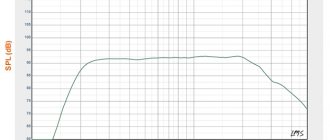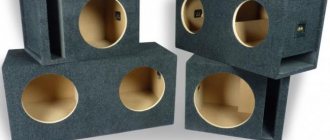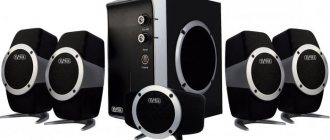A separate acoustic system, designed only to reproduce the lowest frequencies, is included in any sound equipment complex. These can be 2.1, 5.1 and 7.1 systems, which in addition to full-range speakers include a subwoofer. The location of the subwoofer in the room depends on a number of factors. This is the number of satellite speakers, the output power of the system, the configuration of the room and the presence of furniture and soft coverings. Each sound frequency band propagates according to its own laws, so the entire sound picture when listening to music depends on the correct location of the speakers.
Prologue.
Naturally, old furniture may not fit the new room. Then it is simply replaced with one that is made to order or purchased for a renovated room. Well, that’s it, we bought and installed furniture, hung curtains, laid a carpet on the floor and placed designer accessories in all the designated places. There's a TV hanging on the wall. Now you can take on the music system, it’s time for it.
We unpacked our old speakers and placed the CD player and amplifier on the nightstand under the TV. The speakers were placed in the corners - but there was no more room for them. It's time to listen to your favorite records. We sit on the sofa, turn it on, listen. And the sound seems alien! Not the usual one that was before, although it may have been “not a fountain” before. And it “buzzes” somewhere, and “presses on the ears,” and “mumbles.” And I want the sound to flow beautifully and pleasantly, as it should be.
But no. You will have to study the issue of correct placement of acoustics in the room. This greatly affects the sound from the speakers and the sound picture as a whole. Of course, a living room is not a special room for sound recording, where almost everything is provided for the high-quality operation of speakers. But I would like to enjoy listening to my favorite records, cassettes and other things, and not suffer from the “clumsy” sound.
Therefore, we will analyze the main, important points on which the correct, correct reproduction of the sound of the existing acoustics depends. Maybe for many this is already a passed stage. But the article is aimed at those who did not know about this (but had problems of this kind), who did not think much about it before, but are now puzzled. And basically, this information will be useful for novice music lovers to hear the sound from their speakers that is laid out at the factory (although the potential is not always good at the factory). They haven’t even thought about modifications yet, but everything happens someday. :))
How to set up a subwoofer?
If even at the best point the subwoofer sounds “dirty”, and the sound seems to be scattered into the components of the speakers and subwoofer, then the problem may be in the settings. There are few parameters, but they are important.
Crossover
This is the point on the frequency response from which the signal will become quieter in the speakers and louder in the subwoofer, in other words, a kind of frequency gluing. It all depends on what speakers are installed in the speakers. If these are small satellites, gluing can be done in the region of 150–200 Hz, but if these are large floor-standing speakers with 4–6-inch speakers, then in the region of 60–80 Hz, and if 8–10 inches, then in the region of 40–50 Hz .
Manufacturers of professional audio equipment also recommend finding the minimum reproducible frequency and multiplying it by one and a half. For example, speakers can sound up to 40 Hz, then the cut should be made at 60 Hz.
Volume
Responsible for the amount of low-frequency component in the signal. You can start at 12 o'clock, and then twist it to taste. You can also use a noise meter on your smartphone: use a test signal to measure the speaker level, then turn off and adjust the subwoofer to this value.
To get good sound, the speakers and subwoofer must move at the same time as each other in the same direction. Therefore, there is a phase polarity regulator on the subwoofer. If you place it opposite the speakers, you need to rotate the phase 180 degrees so that the sound waves from both sources reinforce each other, and do not subtract from each other.
Sometimes the phase can not only be rotated, but also adjusted with a rheostat, which allows you to adjust it perfectly precisely. There is a life hack for this: you need to stand in the middle between the sub and one of the speakers (the second can be turned off) and ask a friend to turn the phase control. On a track rich in low frequencies, you will notice how these low frequencies shift either towards the speaker or towards the subwoofer. The phase knob should be left in the position where the bass is in the middle between the speaker and the sub.
If you have a sound level meter in your arsenal, you can use another method. To do this, you need to start a test signal at the frequency of the junction of the speakers and subwoofer (for example, 50 Hz), place the sound level meter at the listening point and move the subwoofer until the device shows zero - the waves will be in antiphase. All that remains is to click the toggle switch, turning the phase 180 degrees.
What is more important in a home audio system?
Of course, you can start by discussing the acoustics you are about to purchase. You need to choose it wisely; you shouldn’t think too much about the price and some famous brand, but think more about the possibilities of the room where these acoustics will play.
What is the best acoustic system to buy and install in your room? Usually it happens like this: I saw it, I liked it, I bought it, I installed it. And then you start to think and ponder - where and how to properly place the speakers in the room in order to maximize all the properties? And my head starts to hurt - they don’t play as stated! How to fix the situation?
You begin to think again - “The amplifier is probably not suitable..”, because it is the one that generates the output signal for the acoustics. “Weak. Need to replace". Technologies do not stand still, everything is developing very quickly and is simply begging to be replaced. There were tube amplifiers that became obsolete back in the 70s, transistor amplifiers that became obsolete for the same reason in the early 2000s. The integral ones have already become outdated. There are also hybrid amplifiers.
The CD player itself does not produce what you expect from it - replace it with a modern digital media center with a USB hard drive. “That’s when the speakers will start playing!” But the problem, after careful study, turns out not to be in the technology itself, the acoustics.
The problem is and will remain. She’s not hiding from anyone at all, they just don’t talk about it much. Only knowledgeable and professional sound specialists know. The problem is in the very place where all this is installed! But many of us are given the chance to choose a room in order to organize a room for listening to music or movies very rarely, and often never.
It turns out that such a room is one of the main components of a home audio system. It is this that affects the quality and the very nature of the sound of absolutely any equipment used. There remains only one option - to refine the existing capabilities of the premises to logical (technical) perfection.
What's wrong with the rooms?
Some acoustics owners say that their acoustics are perfect and sound simply “super wonderful!” And in fact, the acoustics play musical works above all praise. But if you buy the same acoustics and place them in your room at home, you may get some confusion! - “What kind of good acoustics is this? It plays like a $100 home theater!” And here, too, there is no doubt that it is so. It’s just that this time the acoustics were installed in a room unprepared for this.
In the first case, some manipulations and calculations were made in the room to combat early reflections, optimize bass and reduce reverberation time. This is the result you can hear.
In the second case, they thought about the speakers first and bought them. At the end of the work of rearranging the speakers around the room, they found themselves “driven” into the corners of the room. The subwoofer took an empty seat near the sofa. The result was such that it can be compared to music from a young man’s car - a huge subwoofer for the entire trunk and three “mids” in each door.
Arranging the acoustics according to your wishes and as required by the “correct installation of acoustics” will not work. And this almost always goes against the design of the room and the arranged furniture. Interior design will not allow this!
Of course, you can allocate a significant part of the family budget and hire specialists knowledgeable in sound and design. After studying the room and making special repairs, they will allow your acoustics to play exactly what is required of them.
It is important to understand that any room is not a special room for listening to music. For example, in a rectangular room, no matter what its size, many reflections and standing waves arise on all parallel surfaces. And all these distortions can easily turn a normal amplitude-frequency characteristic into a seismogram of some powerful earthquake.
Content
Everyone loves fat bass except the neighbors. In audio systems, home theaters and sound bars, the subwoofer serves as the source of bass. Where to put it and how to configure it so as to get the thickest and most readable bass without becoming the enemy of the entire entrance?
There is something grandiose and even mystical in the low frequencies. Not only is bass heard not only by the ears, but also felt by the whole body, but also the sources of bass waves in nature are large-scale events such as thunderstorms and earthquakes. In music, the low-frequency component is the foundation of the track, which forms the groove and quality. In movies and games, bass gives the lion's share of the wow effect in action scenes: explosions, shots, destruction will be flat and inexpressive without low frequencies.
To reproduce frequencies from 20-30 Hz, you need 8-10 inch speakers - boxes the size of a chest of drawers. The subwoofer allows you to maintain low frequencies and reduce the size of the speakers. Essentially, a sub is a large speaker in a separate box. The human ear is not able to detect the direction of low-frequency sounds, so audio systems are equipped with only one subwoofer.
Negative factors of premises.
All the factors discussed below can be figuratively combined in one word, one problem - the resonance of the room. Let's briefly go through the main factors of the negative impact of a room on sound:
The first is Reverb.
As Wiki explains to us, “Reverberation is the process of gradually decreasing the intensity of sound as it is reflected multiple times.”
The presence in a room of a very large amount of reflected sound signal will be expressed in the “ringing” of the room itself. Among experts, this concept is called reverberation time, this is the duration of sound attenuation, expressed by the time it takes to weaken it a thousand times. This is about 60 dB, one might say - almost inaudible sound level. So to speak, an “echo” effect will be heard. Such a room is practically unsuitable for listening to music. It will be very difficult to perceive it normally.
A room that is too noisy will act in much the same way, but with the opposite effect. There is a thick carpet on the floor, a woolen carpet on the wall, which almost completely muffles any resonant sounds, the windows are covered with thick and heavy curtains, and there is a soft sofa.
In such a room, the sense of spatial volume will be disrupted; the listener may not hear the stereo effect at all, and will not be able to focus the sound stage on the ear. Simply, the sound will dissipate in the surrounding environment.
The second is a standing wave.
A standing wave is a sound wave that encounters a solid surface located perpendicularly on its path, is reflected from it and returns along the same route. This is scientific language.
In another way, standing sound waves arise due to reflections and mutual superpositions of low-frequency vibrations, the wavelengths of which correspond to the size of the room. In this case, sharp rises and dips in low frequencies will be heard at some individual points in the room.
Let's look at the picture below. Let's compare the frequency with the wavelength.
The frequencies most susceptible to the resonant influence of rooms are those from approximately 250 to 100 hertz, since they are very close in length to the size of our rooms. Large rooms are good; if problems with standing waves arise in them, it is only at the lowest frequencies.
Third - Early reflections.
Another factor is called early reflections. It is inherent mainly in high-frequency vibrations. The mid-frequency component may also be affected, but to a lesser extent. High frequencies can be reflected from any surface of the floor or walls if the speaker is very close.
Thus, we hear them almost simultaneously with the direct signal from the speakers, which contributes to disruption of the perception of stereo effects and loss of the overall sound image. Also, the uniformity of the frequency response deteriorates due to the phase mismatch of direct and reflected sound. Obvious distortions appear.
Fourth – Fluttering Echo.
The title is strange, but it almost explains itself. As Vicky says, a “fluttering echo” appears when in large rooms measuring 25 square meters or more, when there are two parallel smooth walls or a ceiling and floor, between which there is a sound source.
If you clap your hands in a room and if a quick characteristic echo with a metallic ringing sounds, then this is a “fluttering echo”.
A little differently, a “flutter echo” occurs when sound is placed between parallel, smooth, highly reflective surfaces.
Large living rooms, gyms, and indoor swimming pools are more susceptible to this effect. In short, any premises decorated with any hard materials - tiles on the wall, porcelain tiles on the floor. But in a small bathroom this effect is practically absent, because there is a very small distance between the walls.
Correct placement of rear acoustics
Before answering the question of the location of the rear speakers, it is worth understanding the question of their variety.
If the area of the room for a home theater or audio system is significant, it is better to prefer dipole rear speakers. They are distinguished by greater uniformity of the sound field. This advantage is achieved by simultaneous sound reproduction in two directions.
Direct radiant rear speakers will be preferable for small rooms with two to four viewers. Their strength is a more focused soundstage in the rear of the room.
Having chosen the appropriate type of speakers, you can begin placing them as rear speakers.
Dipole speakers (for example, Definitive Technology SR9040) are somewhat easier to place. If all the home theater seats are arranged in one row, their center is located directly opposite. If there are two or more rows, the center of the dipole is selected between the rows, approximately 2/3 of the distance between them. Such speakers are placed in ceiling or wall mounting. The latter is preferable; in this case, the height is chosen at the level of the viewer’s ears or slightly higher.
Rear acoustics of direct radiation generate better sound effects. But at the same time it requires a certain distance between the sound source and the viewer. Otherwise, the excessively loud sound of such a speaker will introduce dissonance into the overall perception of the film's sound stage. Therefore, if the size of the room allows, such acoustics are placed under the ceiling away from the viewer.
Is it possible to save the sound of a speaker in a room?
There are many ways to “defeat” sound distortion and various unnecessary effects in the room. You can use the services of a specialist with a laser scanner who will make an acoustic model of the room.
In fact, you need to think in advance, even before renovating the premises. And it’s even better to trust a professional in this field who knows what needs to be done with the room so that the sound of the acoustics pleases and brings pleasure.
But this task should not be entrusted to an interior designer. Nowadays, plasterboard is very often used when renovating premises. But few builders and designers know that he is a “lover” of bass; he will “eat” them with great pleasure.
With high and medium frequencies, it will do the opposite - the drywall will simply “bump” them, and very possibly with large overtones of distortion. And a huge floor-to-ceiling window, which is not covered by anything, is simply horror for a music lover who “hears everything.”
Here in the picture below is an example of a room that was prepared by professional craftsmen who are perfectly versed in all the nuances of the correct sound, its reflections and the actual design of the premises.
This is what the acoustic treatment of one of the halls of the Manifold Recording studio looks like. It's about how much work needs to be put in to make the room really sound.
What should you do to fix your room?
We accept the situation as it is. Nobody will allow you to do major repairs, and it’s expensive. We’ll leave the room as is, but we’ll try to fix and improve its acoustic properties with our own hands.
Where to start? From installing speakers!
Since all the thought and fuss is for the sake of the right sound from the acoustics, it’s worth starting with the correct installation of the speaker in the room. If the acoustics have a bass reflex output at the rear, then it is imperative to move it away from the wall. Phasic ports should not face the wall. Otherwise the bass will be booming and booming. And by moving it away from the wall, the “stage depth” will definitely improve and the bass will become softer.
If the bass reflex output is located in the front, then the speakers can be left against the wall, but not too close, leave about ten centimeters. But it’s better to check by ear how they sound, moving them either towards the wall or away from it, at some distance.
Likewise, the listener himself should not be positioned against the wall, although usually sofas are placed close to the wall. There are pillows on the sofa - it will be good if they are behind the listener’s head. You can not use pillows if there is a thick curtain behind the sofa.
It would be ideal to have a separate chair that can be placed in a certain place in the room when the music listening session begins.
Problems with walls.
If the speakers are very close to the wall, then 99% of “early reflections” occur, as well as “standing waves”. Therefore, you need to install speakers at a considerable distance from the walls. Of course, this point is also individual, but the basis for all options is the same, and it should not be forgotten.
You can try to calculate the places in the room where these problems may occur. To do this, you can use a special calculator, like this one for example.
There is another interesting way to determine the location for the speakers. We take the length of the room, divide it by an even factor, and divide the width of the room by an odd factor. Look at the picture below.
For example, a room is five meters long and three and a half wide. Length – 5 meters divided by 8, it turns out 0.625 m. Width – 3.5 meters divided by 7, it turns out 0.5 m. And we draw imaginary lines in the room. It should look something like this. At the intersection of these lines, in principle, you can install speakers in the room.
But all these calculations can help if the listener lives alone in this room. Otherwise, problematic situations with other family members cannot be avoided. Installing “boxes” one and a half meters deep in the middle of the room will suit few people. You will have to compromise and negotiate.
But here we should not forget that by reducing the distance between the speakers in the room, the bass begins to sound brighter, and the very bottom may disappear and be very sluggish. Speaker wires should be kept as short as possible. Hurray, it seems like some of the problems have been overcome.
Acoustics placement.
We've almost figured out how to install the acoustics correctly. But we just found the optimal place in space. They also need to be oriented correctly towards the listener.
The location of the speaker in the room should be such that the listener is in the so-called stereo zone. In the picture below this area is shaded.
But the ideal place for listening is at point M. The slightest deviations from a “direct hit” can cause distortion in the ear, this can be especially noticeable at high frequencies. In most cases, tweeters are designed specifically for this listening position.
But there are some exceptions for some speaker manufacturers. Some acoustics manufacturers do not recommend turning the speakers towards the listener if a ribbon tweeter is used as the HF head. But this is not a rule, but a recommendation for specific acoustics!
If bookshelf speakers are used, they must be placed on a stand of such a height that the HF head is at the level of the ear of a sitting person.
About the subwoofer.
If your home acoustics have a 2.1 configuration, then it’s worth dwelling a little on the location of the subwoofer.
Everyone knows that low frequencies do not particularly require directionality, but this does not mean at all that the subwoofer can be pushed anywhere - as long as it does not interfere.
The place to install the subwoofer is individual for each room. There is no clear solution here. Everything is decided by the furniture itself, standing along the walls and a sofa, possibly standing in the middle of the room, carpeting and the design of the walls and windows. You can find the optimal location for this component without any equipment.
To do this, you can drag around with the sub, moving it around the room, “placing” it in a chair with wheels, thereby looking for a suitable place where it will play adequately. It will actually play differently in different parts of the room. Perhaps an unexpected discovery will emerge - how interesting “non-directional” bass can sound!
There is another option. Place the subwoofer in the listener's place, and look for the highest quality, intelligible and loudest bass, crawling at a level of 40-50 centimeters from the floor. There was a place - there is a place for him!
In the corners of the room and closer to the walls there will be a lot of bass and “hum”, “buzz”. Also, after this you will need to check the subwoofer settings and play with the cutoff frequencies and phase settings. This may improve the situation even further.
How to find the best point for a sub?
Some reference point can be called the golden ratio. Placing speakers according to the golden ratio reduces the influence of room modes and gives the best results. For example, you can measure a rectangle with an aspect ratio of 1:1.618 in each corner, put speakers in the two front corners, and a sub in the back corner.
However, the best way to find the ideal point for a subwoofer is through scientific poking. For example, you can select 10 possible options for the location of the sub and check them one by one, dragging the sub back and forth.
But there is a life hack that will save effort and time:
Place the subwoofer at the listening point and walk around the room looking for the place where the sound will be the fattest, most detailed and intelligible. That's where you need to put the sub.
Sometimes such a point cannot be found. Some frequencies, say 40 and 80 Hz, sound good, but, for example, 30 and 60 fail. The solution may be to purchase a second subwoofer, which is located at the point where the missing frequencies sound well.










